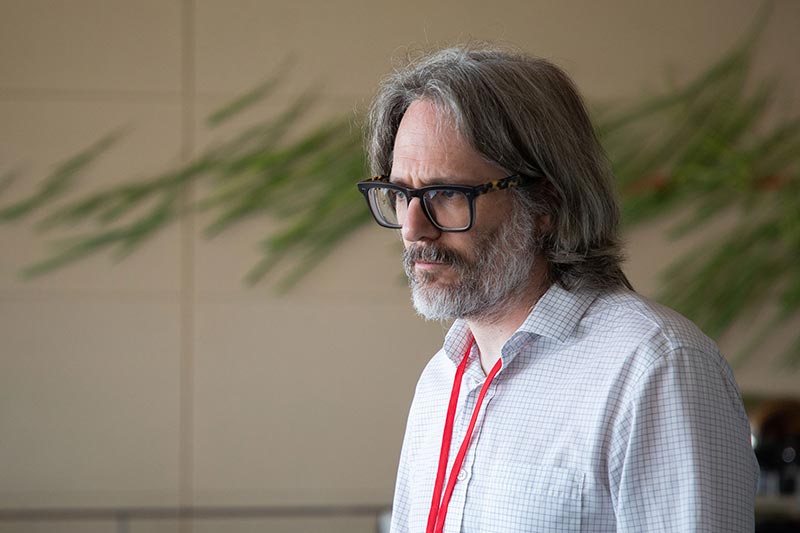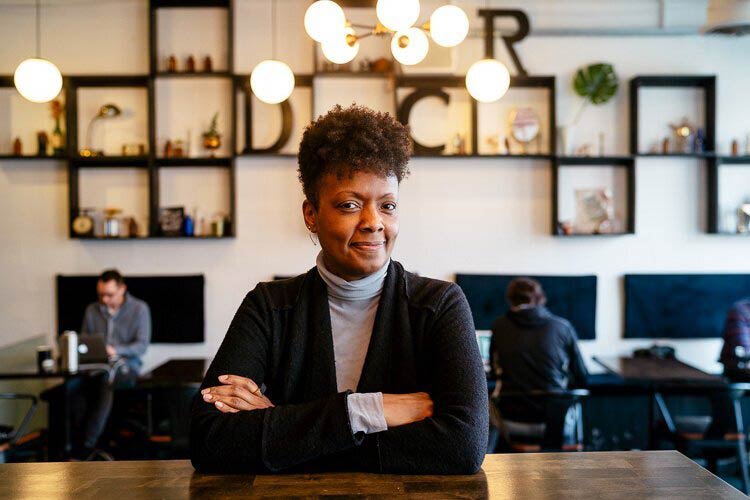
Community Conversation: Coming Together for the Common Good
Katie Johnson, B.S. Arch ’03, M.Arch/M.B.A.’10, Managing Principal at AECOM, and Keiaron Randle, M.U.R.P. ’24, discuss the interdisciplinary approach to equitable, sustainable development.
Randle: At Taubman College, knowing that the urban planning professors talk to the architecture professors and vice-versa, I think a lot of their common themes leach through in our coursework and our discussions. That’s what drew me into urban planning, and so just being able to continue that conversation throughout my education has been really good. Taubman professor Scott Campbell talks about the “planner’s triangle” – the idea that there are three main goals of the planning profession and that we should hold those things in tandem: economic development, environmental protection, and equity. And just the consideration that each stakeholder group has to come together to create a sustainable environment.
Johnson: Education, in particular, is intentionally meant to be foundational and to give you the space to learn those foundational skills. The University of Michigan and Taubman College are quite intentional about fostering that creative systems thinking — what is it that early career individuals need to learn as foundational for the rest of their careers? If I think about some of my favorite architecture courses at Taubman, all of them actually had some sort of planning element.
Randle: I’ve noticed it through the internships that I’ve had as well. Last summer I worked in the Planning Department for the City of Detroit. Through the Community Benefits Ordinance, we would have these mega-meetings with engineers, developers, transit specialists, the architect for the building, and potential residents and community members. Everyone was involved to see it through, from the site review to focusing on the different elements of this huge structure like sustainability, water, the proximity of the building to the river — no one person could focus on every detail. You really have to bring everyone to the table in order to get the development done right.
Johnson: That project you did for your internship is a really great example of how we as professionals try to address systematic challenges, the huge global challenges of our day like equity and climate change. It’s exciting to be part of those conversations but it’s also like, no one’s solved them so far. They’ve only been progressively addressed, right? It really does take complex project teams and big stakeholder groups. Honestly, that’s what excites me about working at AECOM and being here in Detroit. The AECOM internship we have with Taubman College intentionally looks for how we can support individuals who have interdisciplinary backgrounds if possible. The fact that Keiaron has a different background in social work that she’s now bringing to the planning field and then interfacing with all these different people, including architects, that’s where we can potentially create new solutions.
Randle: I think there are moments where sometimes people are left out of the development process. Sometimes community members feel like they’re left out, but that might be because they live outside the geographic boundary of the development. And business owners might be a group that are more often left out because I think we sometimes forget that this development could impact nearby businesses and how would that happen? And what communication is appropriate to help them?
Johnson: I do think that is something, whether through advocacy or process and approach, that architects and planners can bring to the table with the clients and communities that we serve. I think Detroit, particularly with the passing of the Community Benefits Ordinance, has developed some of the processes to think more creatively about engagement as well as how the community can come to the table. And frankly, that stems from a history of disenfranchisement. That’s the big lesson of 1960s and 1970s planning. Whether there are ways that can be improved or not, I think Keiaron and I have both benefited locally from a real conscientiousness about the profession, but that is not to say that is the case everywhere. I think that’s an opportunity, when we have seen successful engagement processes, to share those stories so other places can benefit from them. We should continue to look to other cities as well for good examples. How do we engage people in a way that is actually impactful toward the direction of our design decisions and not performative in nature? Those are the details of what we really grapple with.
Randle: For me, one of the biggest needs we have is diversity of housing in our cities. With the housing supply crisis that we have in what seems like every U.S. neighborhood these days, that would really help. So not just single-family homes, but also duplexes and multiplexes all within one cohesive neighborhood. There should be a mixture of for-sale and for-rent properties together in the neighborhood.
Johnson: I feel like to some extent we’re getting a little bit of the wish right now around climate change and funding. We’re seeing a lot of decarbonization efforts. It’s exciting to me how many cities, counties, states, and firms have decarbonization goals, and it’s started to change the conversation from a return-on-investment conversation to a necessary imperative. We’ve seen some federal funding in particular that has provided a nice shot in the arm to support some of that, but I do still wonder if we have sufficient commitment around decarbonization. We’re really at a practical point right now. Decarbonization is a big-sounding word, but the impact we can have as professionals on our planet, on our built environment and incorporating equity and resilience into those initiatives, is pretty profound.
Portico: Spring 2024
- Cultural Immersion, Catalyst for Growth
- A Kaleidoscopic Career
- Hungry for Change
- Community Conversation: Coming Together for the Common Good
- Scanning Sites with Remote Sensing Technology
- Placemaking and Bridging Communities









